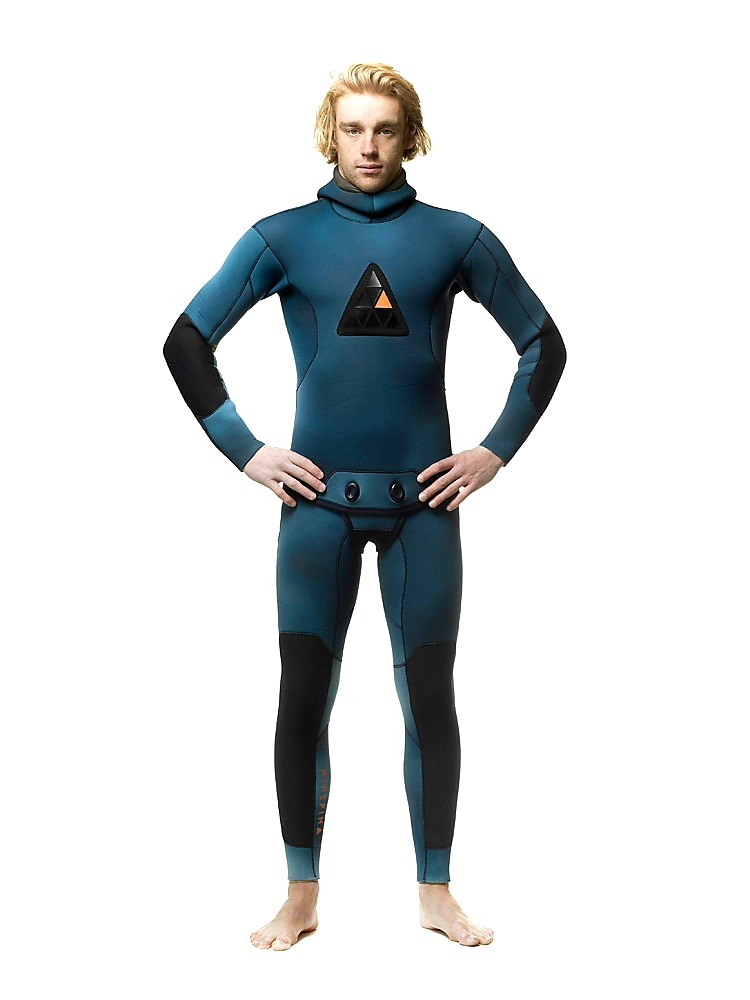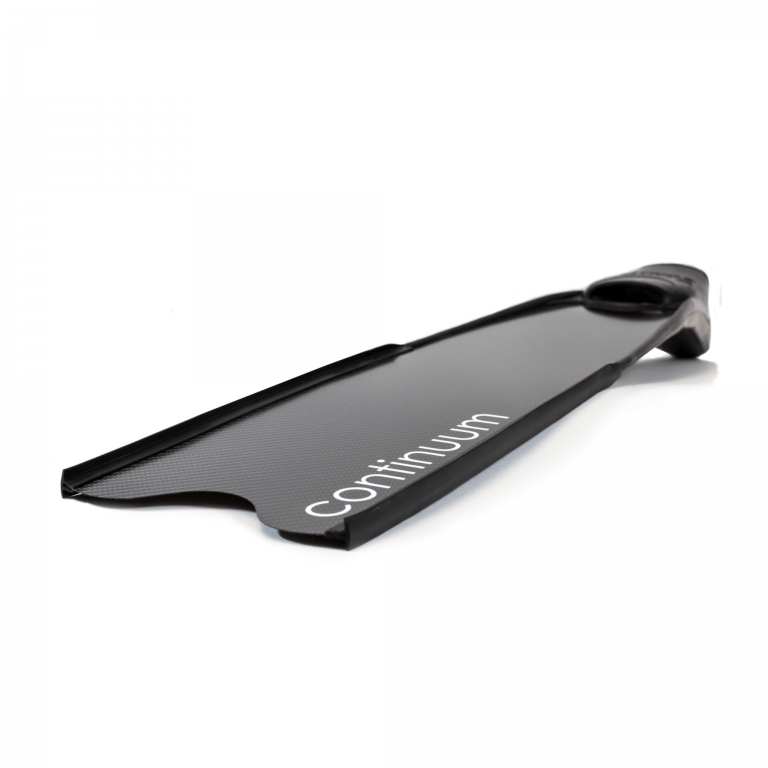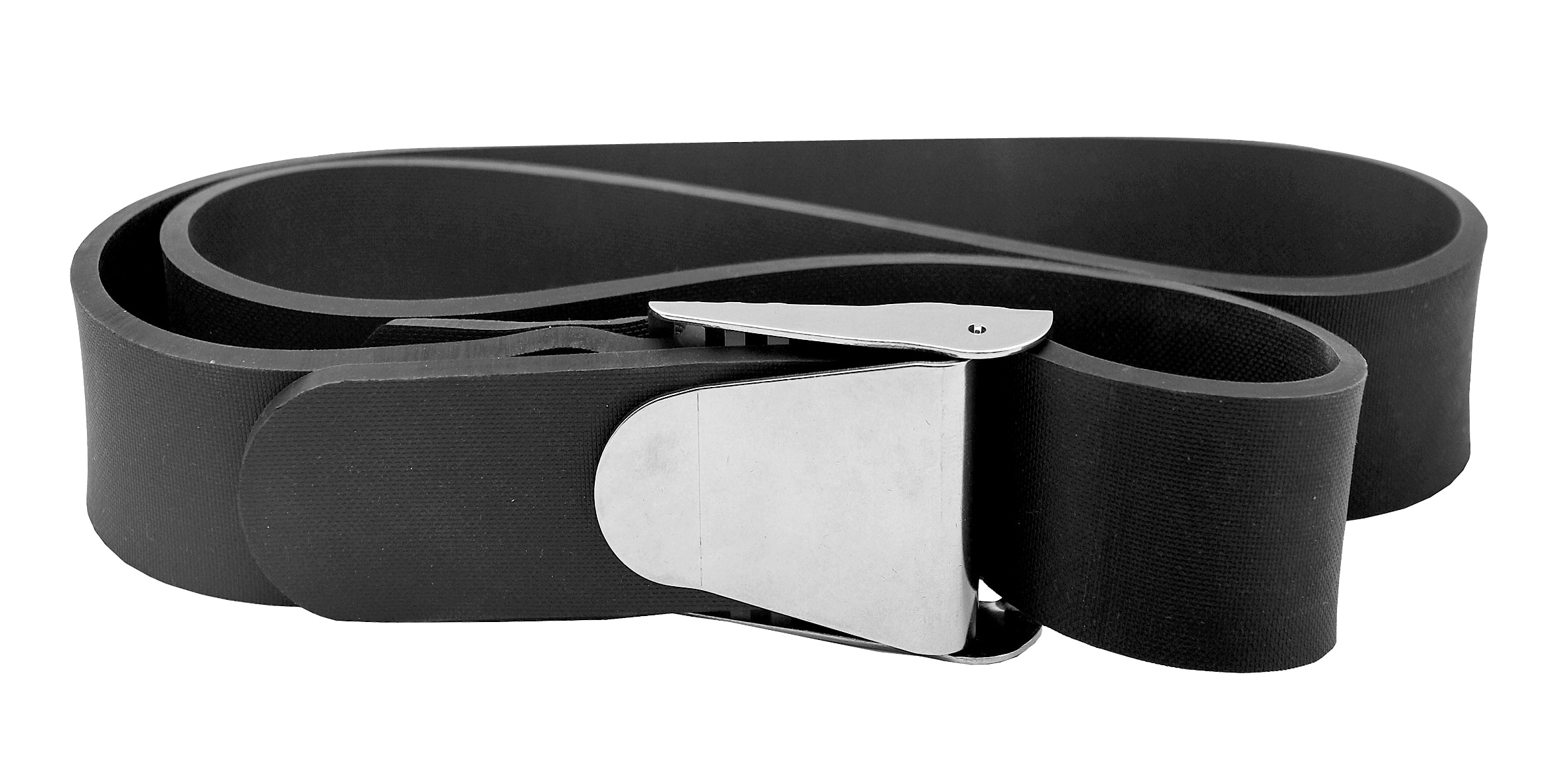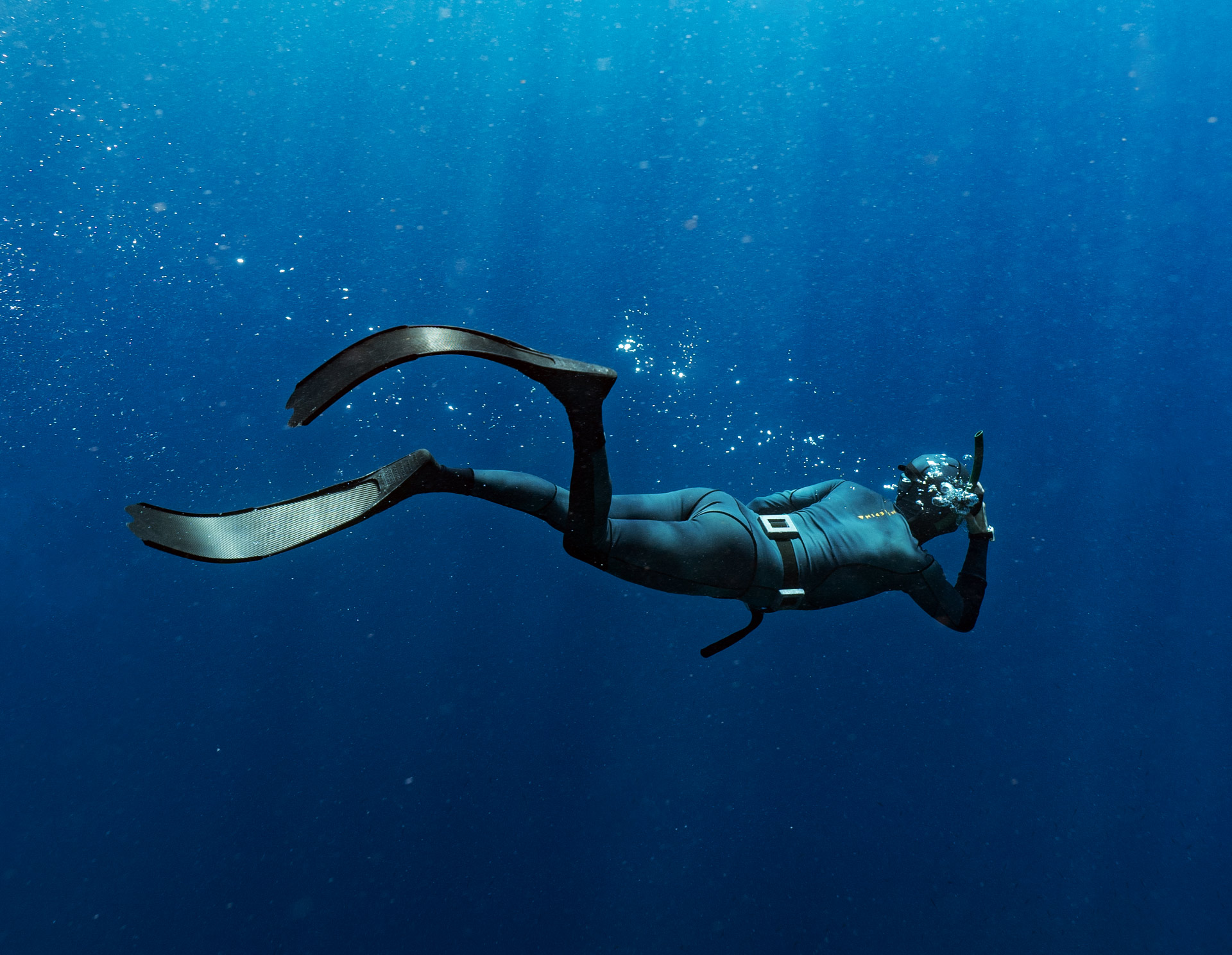
NINEPIN WETSUIT’S BEGINNERS GUIDE TO SPEARFISHING
Spearfishing is one of the best ways to fish for so many reason. It is affordable, sustainable, and most importantly it is a lot of fun. However it can be quite strenuous, frightening and overwhelming to begin with.
To start, you’ll need some standard gear, know-how about local dive locations, and a few spearfishing tips to get started.
In case you have never tried spearfishing or have tried a couple of times and have ended up with little success, then you are in the right place. Our Ninepin beginners guide to spearfishing will hopefully leave you with no doubts about trying out spearfishing, and provide enough tips to help get you out getting wet and shooting fish.
WHAT GEAR DO YOU NEED FOR SPEARFISHING?
Before you go hunting for the kingfish of a lifetime, you’ll need to make sure that you have enough of the right gear to not only land the fish, but manage the ocean in a safe way.
However, the gear you use in Victoria (Australia) might be of no use for the spearfishing spots in Queensland (Australia) or New Zealand. Consulting a professional regarding the equipment may be a lot of help as you’ll be able to use it within that location. We have linked to some of our spearfishing friends at the bottom of this.
SPEARGUN OR POLE SPEAR
SPEARGUN:
The very basic parts of every speargun are a barrel, a spear, and the handle with a trigger function. Mainly spearguns have three main types: hand, band and pneumatic guns.
With the help of air pressure, pneumatic spearguns fire the spear. The old versions of these guns were better performed in deep waters. Nonetheless, the airtight and newer models are powerful in every depth.
Whereas the band guns are good overall, and the preferred spearfishing gun. A little skill is required for loading band guns underwater, but after a few goes you’ll pick it up quickly.
To operate a speargun, the main thing you will need to understand is how to load it. Firstly, ALWAYS make sure the safety is on before you load any gun. You need to have a strong grip around the handle of the gun using one hand because you will need the other to the extent and reach the band.
When you have done with this part, set the handle securely against the center of your chest. Gradually release the handle, and with the use of both hands, keep pulling the band over the shaft until you lock the band in place. Here, your speargun is loaded and ready to go.
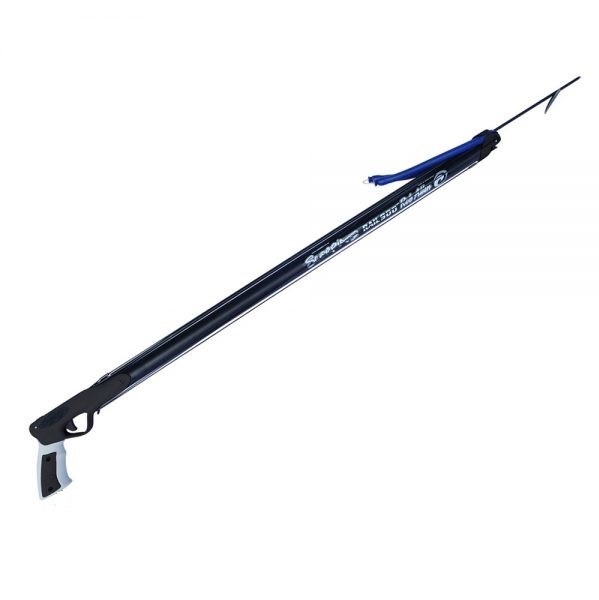 We recommend starting out with a smaller gun around 950mm. If you are happy to spend a little bit, a Rob Allen Scorpia is a fantastic gun. Otherwise, any of the big name brands guns will do – Beuchat, Picasso etc.
We recommend starting out with a smaller gun around 950mm. If you are happy to spend a little bit, a Rob Allen Scorpia is a fantastic gun. Otherwise, any of the big name brands guns will do – Beuchat, Picasso etc.
Pole Spear: A pole spear is a weapon that can be made up of fiberglass, graphite, wood, aluminium, or carbon fiber. These pole spears are normally of 4 to 10 feet long that has a top that is threaded to cover the spear tip. You will find two primary types of spear tips, i.e., the single-pronged shaft (Tahitian) and the three-pronged paralyser. There is a rubber band at the end of the spear.
To fire using a pole spear, hold the pole using one hand, and then use the crook of the thumb to pull the elastic band. You will need to pull away from the bottom of the pole spear to the top so that tension is created. If you pull too hard, your pole will start to bend, especially when the pole is longer than 8 feet. To avoid the bending of the pole, try twisting the shaft like you are pulling it around the band.
Then using the same hand, tighten the grip on the spear and free your other hand because it’ll need to get a hold on to the retrieval rope. Now, aim to keep your arms out and let go to fire the spear. To retrieve, pull the rope.
SPEARFISHING WETSUIT
Depending on the water you are diving in, one of the most essential items that you may need before going spearfishing or diving, in general, is a wetsuit. You will find many types of wetsuits depending on the temperature of the water.
For spearfishing, you need to consider the thickness of the suit, especially when you dive in warmer climates. You can go for a rash guard if you are diving in tropical waters where one isn’t required.
In colder parts of the world (Especially here in Melbourne, Australia), a wetsuit can be required for diving at all times and thickness will be dependant on the water temperature. Here at Ninepin Wetsuits we have a range of wetsuits that are suitable for everyone. If you are going for a complete wetsuit, choose one of our brand new camouflage wetsuits.
FINS OR FLIPPERS
To achieve an enhanced spearfishing performance, you’ll need a set of fins (or flippers) to help you manage the ocean. The better the fins the less work you have to do out there to get around, dive and also get our of trouble in stronger currents and swells.
You can go for fiberglass, carbon or plastic fins. For a beginner, to save money, we would recommend any but be careful where you dive if you buy cheap as you may not be able to generate enough power in fast moving water. If you are interested in better-looking fins that also require lesser energy expenditure, you can choose fiberglass fins.
If you’re looking for a perfect set of carbon fibre fins our friends over a continuum fins can provide you with a set that is made to order. The whole Ninpin crew uses them!
MASK AND SNORKEL
The most important thing is to avoid choosing a mask that looks “cool”, we’ve made that mistake before. Go into a store like Adreno and try on all of them until you find one that fits your head perfectly! Try the masks without the strap, breath in a little air through the nose so that an airtight seal is created. The mask is just for you if it stays on your face.
Then make your choice depending on the one that allows most visibility. Well, that doesn’t mean you should choose see-through lenses as they are best just for clear waters. If you dive in an area with low-visibility, choose coloured lenses because they are designed in a way that they increase contrast and offer much better vision underwater.
FLOAT, FLAG, AND LINE
Once you have caught your fish, you are not done with the job yet. We recommend not attaching the fish to you, as this can help avoid predators coming at you for the dead fish. A float with a catch bag or line will hold your fish for you but also keep them away from you.
The bouy with a flag will let other people in the water, or people on boats or jetski’s know that you are diving in the area. This will (should) keep you out of harms way when it comes to powered watercraft coming too close to you.
KNIFE
As for every ordinary knife, the one used for spearfishing has to be always sharp, resistant to rusting, and highly durable. Contrary to the belief, a spearfishing knife is not only used for hunting fish but also for cutting ropes, lines, seaweed, and objects that you may find difficult to pass through or that you may entangle yourself in underwater.
But the main use of this knife will be for finishing off your catch in a humane way. Choose a smaller one with sharper edges that may be easier to manage.
Spearfishing knives can also keep yourself safe, and you need to look into the quality while choosing one.
SOCKS AND GLOVES
Gloves are quite helpful for offering protection and warmth for your hands without bothering you while you reload your speargun. The one that you wear while surfing that is thin might work, but it is recommended to choose the fishing gloves to ensure that they are comfortable and lightweight yet well-built for the job.
Socks or booties should also be thick enough so that your feet are kept warm and are a soft barrier between the fins and your feet. It’s important to know what size you can wear in your flippers without squishing your feet. Booties don’t last, you go through them pretty quickly, so stick with the one that feels comfy and isn’t too expensive.
WEIGHT BELT
To make sure that you do not end up floating on the surface while you are wearing your wetsuit and being unable to dive, you will need a weight belt that goes around your waist. The weight belts are designed to hold onto the lead weights together so that you know that you are wearing reasonable weight for your body to gain neutral buoyancy when you are diving. We recommend a rubber belt and then buying enough weight for you, which someone at a store will be able to help.
-
SAFETY FIRST
Spearfishing can bring in various types of dangers, i.e., sharks, currents, swell, people. Nonetheless, the most dangerous case for a spearfisher that is themselves. Knowing your limits, being aware of your gun, knife and situation you are in will determine how safe you are.
In reality, drowning should be a very serious issue for every spearfisher, no matter what level they have reached. Thoroughly go through the diving tips!
-
DIVE BUDDY
Shallow Water Blackouts – about which you’ll learn further, results due to lack of oxygen inside the brain called hypoxia. Whenever this blackout takes place, you have only about 2 minutes to respond before the brain damages, and death impends. That is the reason why you should always dive with a buddy. This is not an option but a requirement, no matter how experienced you are, never dive alone.
-
START SMALL
This is the ultimate rule, starting from your diving location to every fish you catch. You should not target anything that cannot eat, but for a start, try shooting down smaller fish. One can easily get discouraged while spearfishing, yet this is a better way to build up your confidence.
Also, dive near land and jetties when you initially start. You will have the opportunity to hide behind obstacles, and the water is shallow, which will make it easier for you to sneak up on fish.
-
SAFE DIVING
The essential component to spearfishing is becoming a good diver. Practice safe diving before you come into spearfishing. Start from practicing in shallow water, work upwards, or down into the deep water gradually. Make sure that the aquatic environment does not upset you before you buy the gear.
-
BREATHE TRAINING
For an experienced diver, it is a standard to be able to hold their breath for a couple of minutes. Having such control on your breath will allow you to pick a location in the water, behind a rock or on the seafloor, and wait for a fish to come along.
You need to improve your breath holding ability, but that also while taking every possible precaution. This will take time, and you will gradually develop it. But try staying warm, and moving slowly will improve your breath-holding. Don’t push your breath while you are diving; you cannot risk the Shallow Water Blackout. However, you should always remember that breathing up doesn’t mean you have to get oxygen into the body but to relax!
PRACTICE ON LAND
so far, we have gone through the instructions about what you are supposed to do in the water and all the other deep water training. Nonetheless, there are few land practices that will pace your diving experience and lead you to be a better diver.
- Get a grip on the ocean: read, watch YouTube, practice while you are on the solid ground, where you need not worry about the buoyancy. There’s a huge array of information online, or jump in the forums. For breath holds, find yourself an open area, home, beach, or a park and practice breath holds. Start small and focus on hitting a time limit, you may start off with 60 second holds, but make sure you have double the time break. So 60 seconds holds requires 120 seconds of breathing before you attempt a breath hold again.
- Yoga and exercises: a little time of your day spent on the daily exercises will not only improve your health but also helps you to improve diving. Arm and upper body exercises make the gear-holding task easier. Focusing on the leg muscles will help you in better finning techniques and decreases the chance of muscle cramps. The most important component yoga helps you to master is the breathing techniques. Keeping fit makes a huge difference.
FREE DIVING COURSES
Freediving is a fun and easy sport to start with. Many spearfishers and free-divers get interested in the sport and learn from their friends and families, but if you have not learned from n expert, the sport can get risky. Despite the lack of equipment, there is a lot to learn while you are free diving, especially the safety concerns, techniques, and one should always be aware of the risk. A free diver who is badly trained can risk suffering anything from sinus, lung barotraumas, ear, blacking out, and not to mention drowning.
You shouldn’t be scared of the sport but enjoy it with complete safety. Many spearo’s out there who don’t bother to complete their diving course tend to be doing things wrong and could develp bad tendancies. Once the course completes, you will find your ability will skyrocket with a great deal of confidence as you will know about moves and the way of them being done safely.
On a regular freediving course, you will be taught the following,
- Depth and pressure: how does physics affect your body and diving underwater.
- Equalization: the multiple methods and know-how to overcome the issues concerning equalization
- Equipment: the choose of the right diving equipment according to your ability and physique
- Breathing: how to control breathing while diving and how to breathe after it
- Rescue skills: including rescuing a buddy and also self-rescue
- Weather: a better understanding of currents and tides
- Risk awareness: planning and managing a dive session
- The underwater environment: to know about marine life and to know what to avoid and what to catch
- Pool training: dynamic and static
- Buoyancy control: improving efficiency and hydrodynamics
- Open water training: constant weight and free immersion
Some of our recommendations in Victoria:
SHALLOW WATER BLACKOUTS
Hypoxic blackout, also known as Shallow Water Blackout, can affect anyone who is holding their breath, even to a swimmer who is physically fit and experiences swimming daily. The blackout is usually found in competitive swimmers: snorkelers, Navy Seals, spearfishermen, or the one who is freediving. Shallow Water Blackout is a spectrum that may affect a swimmer or diver of any level.
Basically, this triggers one to breathe in the elevation of carbon dioxide and not the low oxygen resulting in one to faint or ‘blackout’ in the water. In some cases, the person to take in water to their lungs that lead to drowning, and in other cases, the person simply suffocate to death. Shallow water blackout happens when one is not well aware of the dangers of holding breath.
As we’ve mentioned before, never dive alone. But also make sure you at a minium read up on how to save someone who does black out or what’s required from you as a dive buddy. Choose a smaller one with sharper edges that may help you to cut objects easily.
-
ONLY CATCH WHAT YOU ARE GOING TO EAT
Being a spearfisherman, you should never fish for a photograph or for any reason other than eating. You catch a fish only with the intention for it to be your dinner. There are many cases where people fish giants for a mere picture and later have no idea about what to be done with the fish. They are found rotten lying on the beach for no better cause.
Know What You Can and Can’t Shoot
When you begin a new activity or sport, you can unintentionally make a lot of mistakes. Before stepping into the water, take a thorough look over your abilities. Here are the common mistakes made by the rookies and make sure you keep these in mind while you are in the water.
- Shooting undersized fish: learn and check the size regulations. Do not shoot marginal fish; you are even given the advantage to mark sizes on the spear.
- Shooting from too far: calculate the flight distance depending on the fish. Learn that most groupers and snappers require long shots.
- Never hold out a dive that extends your limits: keep enough time for yourself to come back to the surface. Never extend your limits.
- Avoid sea lions and other animals underwater: remember that in the wild, you will find WILD animals, might seem cute until you get attacked upon.
Respect the Ocean
It is a hunt, not a slaughter. Always be selective, conservative, and respecting the environment is as important as the sport itself. The matter is not to just go out into the water and shoot down the first moving thing you witness. Being a spearfisherman is more of a commitment and a job of many responsibilities. We go into the water for fun and dinner.
The sport requires a high level of awareness and consciousness together to be sustainable and help to maintain the ecosystem in a better way,
- Chasing the fish and jerky movements: these types of actions will alarm the fish and chase away others. Slow down, blend into the water, relax in the environment, and then get closer to your target.
- Wrong fish identification: do not aim just any fish you like. Get a book guide or learn the shapes, skin appearances, marking, and behavior of your prey before attacking. You don’t want to attack the fish that cannot even be eaten later.
- Respect the minimum sizes: before jumping into the water, read about the species and the sizes for each one.

